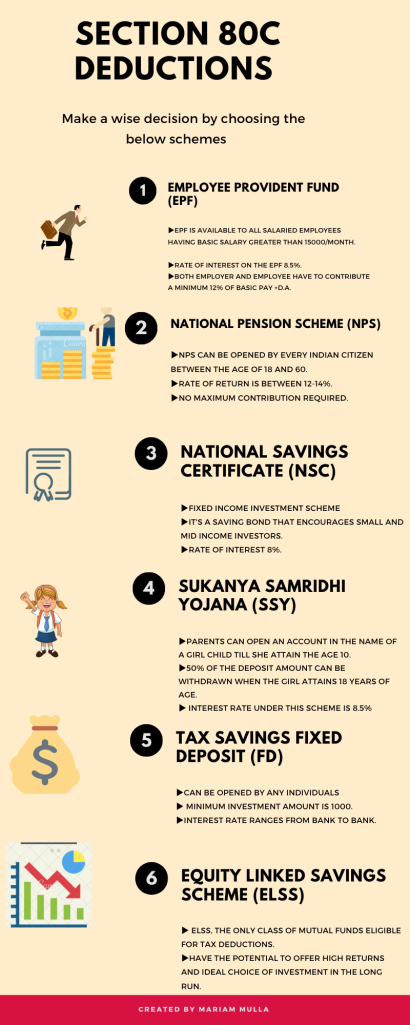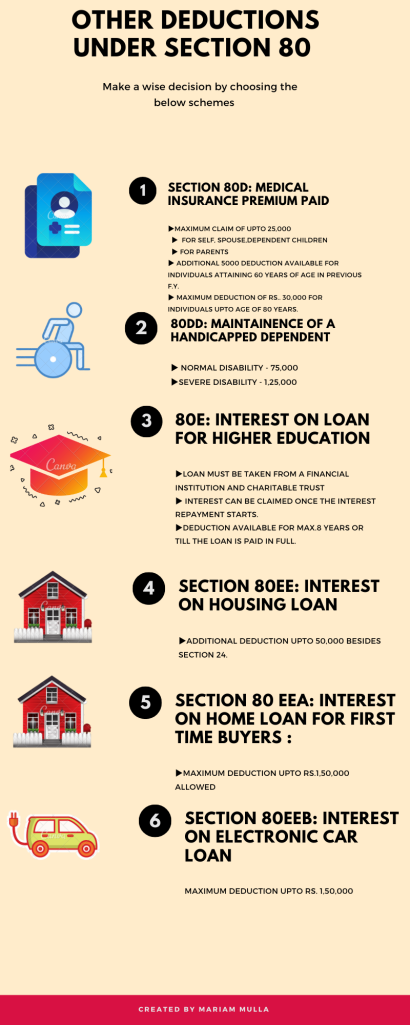Since the Financial Year 19-20 has neared its closure, the books of accounts need to be closed. So everyone must be seeking on advice from their tax consultants for tax saving options as your previous year's income will be taxed in the current F.Y 20-21 or say A.Y. 20-21. Since the covid-19 outbreak has been a barrier to many of our financial difficulties, here are some simple and quick tips that I would like to share. Starting with the first :
1. Section 80C deductions
Well, it's a package of various eligible deductions that one is looking for. It comprises of investment options like LIC, PPF(Public Provident Fund), Suknaya Samridhi Account, Mutual funds, Fixed Deposit etc. But before that, I would like to explain what is deduction? A deduction is something which reduces the taxable income. Your tax is calculated on the net taxable income which is obtained by deducting your gross total income with this deductions.
2. Section 80CCC
This is nothing but your pension funds. You can claim this deduction by contributing to any pension plans.
3. Section 80CCD(1)
Well, this deduction deals with investment in Atal Pension Yojana and contribution towards National Pension Scheme. Atal Pension Yojana is a retirement oriented scheme which provides regular income to investors after their retirement. This section applies to both self-employed and salaried individuals. If you are a salaried employee then you can claim the maximum deduction of 10% of your salary which includes basic salary and dearness allowances. If you are a self employed individual, then you can claim a deduction up to 20% of your gross salary i.e. basic salary and dearness allowances. There's also additional section 80ccd1(b), which gives you an additional tax benefit of Rs.50,000 for contribution to NPS account.

4. Section 80CCD(2)
This section deals with the contribution to NPS account by the employer. Besides contributing to the EPF account as we had seen earlier in section 80C, the employer can contribute to the NPS account of his/her employees as well. Under this the contribution by the employer would be as follows: 14% of salary in case of a central government employee (whichever is lower) and 10% of salary in case of others(whichever is lower).

5. Section 80D, 80 DD, 80 DDB
These sections particularly deals with medical insurance premium and medical expenditure (upto 1,00,000), Medical treatment of a dependent with disability (Normal Disability :Rs. 75,000/-, Severe Disability: Rs. 1,25,000) and specified diseases (senior citizens:upto 1,00,000 Others: upto 40,000)respectively.
6. Section 80E, 80EE,&80EEA & 80 EEB
This section deals with the interest payments towards Higher education loan, Home loan, first time home buyers respectively. The deduction under section 80 E can be claimed only after loan repayment starts. Point to be noted is that a person repaying loan can only claim the deduction under this section. There's no maximum or minimum deduction limit. The deduction can be claimed only when it's taken from a) Financial Institution or b) Charitable institution. section 80EE deals with interest on housing loan with a deduction up to Rs. 50,000 subject to some conditions. Section 80EEA deals with interest on home loan for first time home buyers. While section 24 allows interest deduction of Rs.2,00,000, section 80EEA allows additional deduction of Rs.1,50,000 to home buyers. Section 80EEB deals with repayment of electronic vehicle loan. This section has been introduced lately in the Union budget. The deduction limit under this section is 1.5. Lakhs.
7. Section 80G, 80GG, 80 GGA, 80 GGB,AND 80GGC
This section is related to donations. Donations exceeding Rs. 10,000 should not be made in cash. Section 80 GG is for house Rent paid. You can claim this deduction only if you don't avail HRA from your employer in case of salaried employees. The amount of deduction can be the least of the following 3 conditions a)Rs.5000 p.m. Or Rs.60,000 yearly. b) 25% of total income c) amount obtained after deducting 10% of income from the amount paid as rent in the respective F.Y. Section 80 GGA is Donation to Scientific research and development. The amount given as donation is fully allowed as a deductible. Remember not more than Rs. 10,000 can be paid in cash. 80GGB is donations to political parties, the condition is similar to GGA. Section 80 GGC is a contribution to political parties by an individual. Deduction cannot be claimed if paid in cash.
8. Section 80TTA & 80 TTB
It's about interest earned on savings account and on FDs respectively. Interest deduction for a savings account is allowed only up to Rs. 10,000 above which it will be taxable. 80TTB is beneficial to senior citizens (60 years or more) deduction is allowed up to Rs.50,000 beyond which it is taxable.
9. Section 80U
This section is for Individuals with disability. Normal disability, deduction up to 75,000/-, Severe Disability, deduction upto 1,25,000 allowed.
Note: All the deduction under section 80C should not exceed the aggregate limit of 1,50,000 for claiming of deduction. The standard deduction for the salaried class has been increased from Rs. 40,000 to 50,000.
Thank you for patiently reading. Stay updated for the latest news, and amendments in Direct Taxation.









 CAclubindia
CAclubindia

